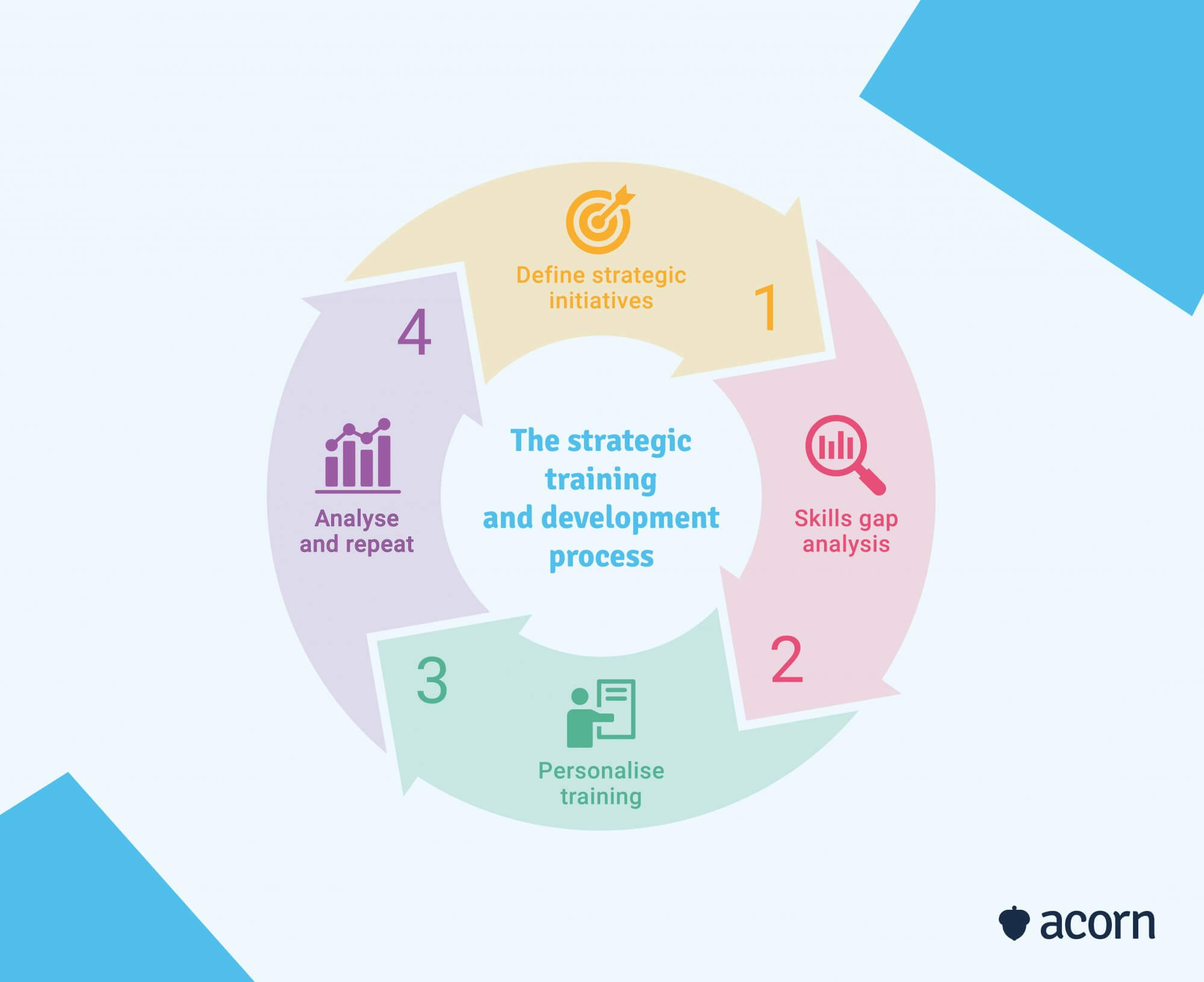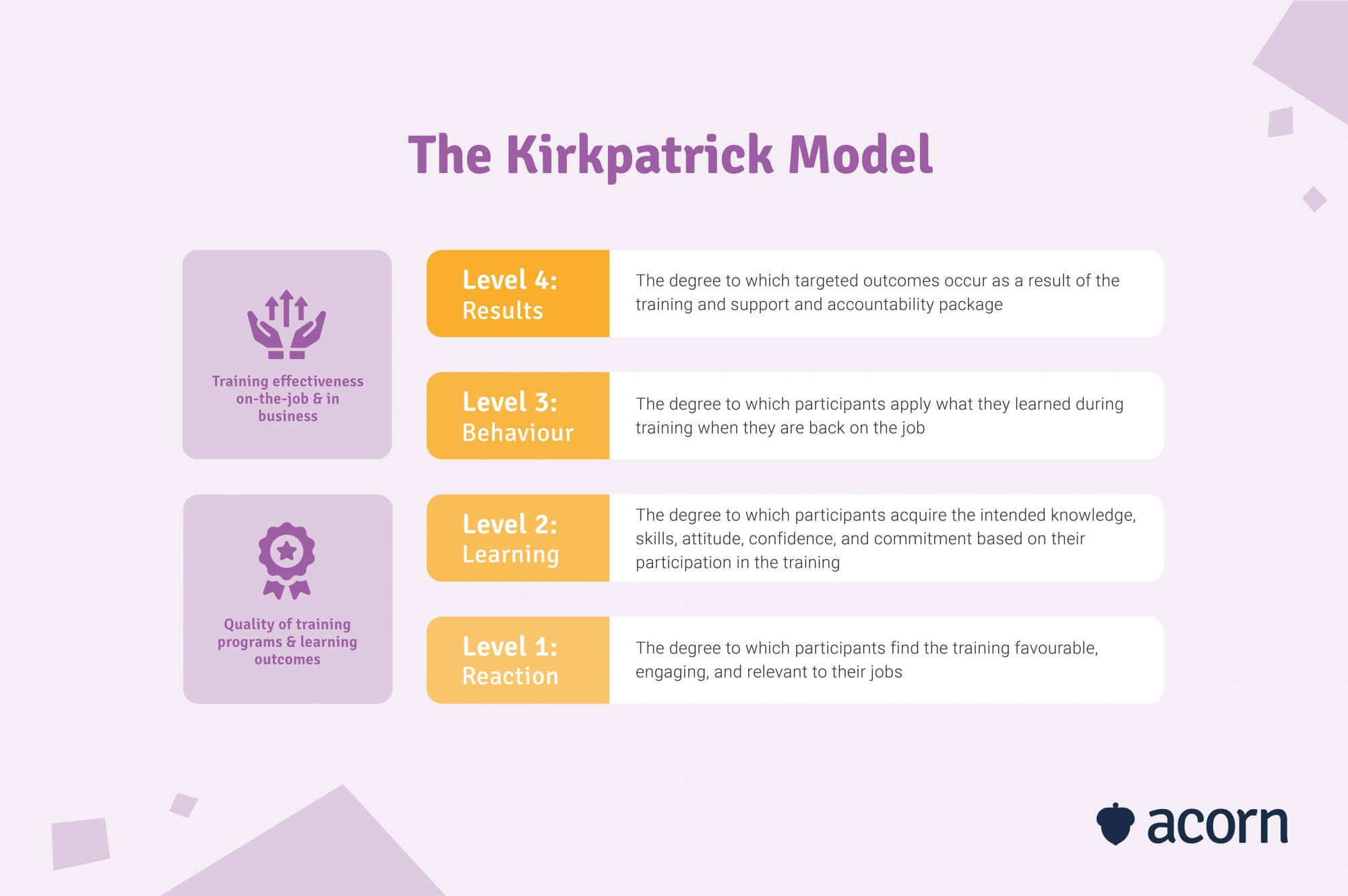Why Strategic Training and Development is Essential for Long-Term Business Success
Reading Time:

Lead the pack with the latest in strategic L&D every month— straight to your inbox.
SubscribeStrategic training and development is a vital factor in the long-term performance of any company.
Training programs come in many forms, depending on the organisation. What all should have in common is a strategic focus. That is, company goals the program will impact.
Strategic training and development ties individual learning needs to business results. Not only does this give employees a better sense of purpose, it ensures that job roles and every day work are truly driving business success.
Let’s walk through the steps in the process as well as examples of strategic training and development that you can easily implement today.
What is strategic training and development?
Strategic training and development is the process of designing specific employee training programs that directly align with business needs. Training with a strategic focus develops the capabilities and tools that employees need to successfully carry out their jobs. In turn, the capabilities gained give organisations a competitive edge.
What is the strategic training process?
The difference between regular employee development and training with strategic goals comes down to a few characteristics.
- All development activities are based on the strategic objectives of the organisation.
- The learning framework is general enough to be applied to any business function’s needs, but specific enough that it can address niche training requirements.
- Continual reporting, analysis and iteration is a core part of the process for L&D professionals.
- Management are key champions.
- Training activities are tailored to personal needs to ensure learning sticks.
The above must exist and be routinely utilised in a strategic training process, particularly one that supports human resource management. At the centre is a performance outcome or behavioural change. Thus, the main differentiator is that strategic training and development programs look long-term.
What are the steps in a strategic training and development process?
This process is always rooted in business-level outcomes. While you’re looking for performance outcomes at the individual level, these outcomes need to have business impacts. It’s also a cyclical process where each step informs the next.

Define strategic initiatives
If we’re thinking long-term for current activities, we need to start at the top: Business strategy. What is the ultimate business value that any given training program will provide?
If you don’t know what you’re trying to achieve, you can’t effectively identify or track results. And even if you do experience a positive result, you probably won’t be able to accurately retrace your steps to replicate it. This is why we want to have quantifiable training initiatives.
Look at your business drivers. This is usually where organisations pull from strategic planning tools like a capability framework, because these are what make a business effective. If you don’t have one, there are two ways frameworks derive business drivers.
- Public sector capability frameworks look at key high-level behaviours and attributes.
- Private enterprise frameworks often develop capabilities from business units and technical and leadership skills.
Content creation, customer management and predictive analytics are capabilities derived from business functions. Human abilities like leadership, collaboration, and decision-making are also developable capabilities that impact the bottom line. To make these initiatives, we just have to think about the link to job performance.
This is where legacy learning tech is going to let you down. Most LMSs focus on plugging massive content libraries that force learners to wade through largely irrelevant content. If they do complete training, you base improvement on completions, which shows nothing but that they ticked a box.
It was this complaint that lead us to create Acorn performance learning management system (PLMS), a first-of-its-kind learning solution that guides learners step-by-step to master the specific capabilities of their roles. That includes curating content and mapping it to those specific capabilities, so learners so only what is relevant to their capability needs, and capturing experiences that are happening outside the platform and transforming them into learning assets.
And given learning starts and ends with capabilities, this enables reporting that shows true business impact, thus proving the strategic nature of your training and development.
Find your gaps
Whatever the initiative, you want key performance indicators (KPIs). KPIs are what make strategic training an iterative, cyclical process and, well, strategic, as they give you a measure of change.
Start by prioritising capabilities based on the impact they will have on desired business goals and the availability of said capability within your organisation. This comes down to performance.
Observation, performance reviews and even time tracking can give insight into how effectively employees apply capabilities. We note this isn’t breathing down people’s necks or questioning why they spent so long on something. It’s an objective analysis of the way work gets done.
Say you realise Project Management is the lynchpin capability for an upcoming project, because there’ll be multiple players from different teams collaborating. But it’s sorely lacking in a young, junior-level workforce. There’s the training opportunity and priority, all in one. It also means there are ample practice opportunities, too. To define KPIs, think about what the end goal of performance is and the progress towards it. Consider quantifiable training metrics (efficiency, quality, time) as well your reporting periods—KPIs need to be achievable.
Personalise activities
Training can be a change strategy, but only if it reflects how people work. Consider the day in the life of employees. What are they good at and why? Does a Technical Support Officer excel when talking with customers because they are empathetic or because they understand the technology well enough to explain it? What are the blockages (new skills, processes or technology) in their workflow? How do they structure their days?
Any program should be practical to an employee’s day-to-day, while the mode of training should complement it. As much as we’re thinking long-term, training needs to be accessible, timely and relevant in the interim for employees to engage with it.
This is where managers are key. They should be openly discussing career progression and preferences with their employees (because managers directly impact the way training is viewed in the workplace culture), even co-designing the process.
Consider modes of training like:
- On the job training, such as mentoring, coaching and job shadowing. These are beneficial for behavioural capabilities like people leadership, because true development translates theory into actions.
- External learnings through third party providers.
- Long-term study, such as a graduate certificate.
- Short-burst training e.g. video-based micro-courses.
- Online training as accessed through a learning management system.
You could take a holistic and experiential approach through a blended learning experience that combines any of the above. Let employees choose topics of training that interest them, too. These can be drawn from your pool of capabilities or business drivers, even if not necessary for one’s job. An IT professional looking at the psychology of product design, for example.
Analyse impact
This is the step that makes the process cyclical. It’s also where you show the ROI of training, ensuring that organisational value is easy to convey because:
- You’re not making assumptions
- Training is truly impactful on employee day-to-day
- Learning outcomes are solving business pain points.
If this all sounds familiar, it’s because we’re borrowing from the Kirkpatrick training evaluation model. The focus is always on tangible outcomes that occurred—and only occurred—because of training.

In this case, you can use learning-based metrics like:
- Content completions
- Progression rates
- Performance reviews
To better understand organisational results such as:
- Customer satisfaction/complaints
- Employee satisfaction/engagement
- Project/process iterations.
Whatever insights you gain here you funnel back into the process. Say increased customer satisfaction was an intended outcome. Satisfaction scores haven’t increased in the three months since support staff were meant to undertake an emotional intelligence. Look to the content completions and progression rates. If they’re low, you may need to revisit program design to boost engagement.
Examples of strategic training and development programs
Before you dive into fleshing out a program, keep in mind that some training may not be strategic even if important to your business. That’s training like:
- Compliance, which is crucial for obvious reasons.
- Onboarding. It sets the tone for new hires, but the knowledge shared is usually only beneficial for getting the lay of the land in their first few months.
- Product. This keeps your engine running as knowledge critical for certain job roles.
The key difference between these types of training and training with strategic impact is that they are niche topics for a certain moment in time. Strategic training looks long-term, often encompassing short-term initiatives.
Initiative: Leadership development
Leaders are the core of workplace culture, which means any displays of agility, resilience and strategy filter down to employees. Equally, any negative attributes (poor delegation, opaque decision making, lacking business knowledge) will be obvious to those leaders are meant to influence.
Obviously, leaders aren’t just born or developed overnight. Having a talent pipeline to promote from takes time to develop, but it should be started as early as possible since leaders are the make-or-break role in your organisation. It’s easier to develop the leaders you want and need.
Program: Mentoring
Leadership is something that is better learned than studied. Ergo, opt for a largely face-to-face approach that’s reinforced by online modules on topics like conflict resolution. Many great leaders will say experience is what sets them apart from junior roles, because experience provides context. Mentoring benefits both mentee and mentor, since it builds new knowledge in one and develops and reinforces skills in the other.
To establish a mentoring program, start by identifying the people best for mentoring and being mentored. Bring it back to capabilities and authority. Who in your organisation is highly proficient? Who do employees routinely turn to with questions? Get managers to spotlight employees who either want to undertake mentoring or would benefit. The key thing to get right is matching mentee and mentor by capabilities, personality (hint: too similar can make for echo chambers) and experience.
Initiative: Social learning
Don’t knock it. Even at our most introverted, we are generally a social workforce. Think of the mission-critical knowledge that is shared in non-trackable ways: Between peers throughout the day, within meetings, on the coffee run.
Your competitive advantage is being shared here, without you even knowing or encouraging it. (Think about cross-cutting decisions.) And knowledge sharing depends on your culture. Poor culture means knowledge is more likely to be siloed. So, encourage social sharing.
Program: Lunch & learns
Informal but impactful. That’s how we’d sum up the lunch and learn. Not all training needs to be extremely formal—social learning is an easy way of quickly improving employee knowledge.
Lunch and learns bring the benefits of:
- Efficiency. Training may be a luxury in smaller teams. Inviting guests or having team members “preach” to their peers during the working day can be cost and time effective.
- Cross-training. The communications team talking about marketing strategy can be insightful for the customer team, who they may not interact with otherwise.
- Being geo-agnostic. A remote workforce means scattered information and a lack of tacit knowledge, but the convenience of video calls makes lunch and learns accessible to all.
It also means you can relay new or updated information faster. The product team may give a presentation on an upcoming launch, and with that comes the specialist expertise they have of the product. Other employees can ask questions as they need and get answers immediately, removing the potential for miscommunication later.
Initiative: Capability building
There’s not a lot to say here that hasn’t already been said. Capabilities—technical or soft, core or complementary—need to be continuously developed in your existing workforce as they determine your long-term success. Sometimes, you can’t hire for emerging skills. That’s where the stretch assignment comes in.
Program: Stretch assignments
Keeping high performers engaged is tricky. They learn and evolve quickly, so a challenge isn’t a challenge for long. Stretch assignments are often labelled soft promotions as they add dimension and responsibility to an employee’s job, while helping solve a business problem. While not entirely exclusive, it’s also something you can trial on a small group of employees—namely those who are starting to outpace their current role.
They’re truly impactful and easily implemented because they get employees on the ground. Training is practical, immediately or directly impacts the business and is reinforced by social sharing, making it low cost. Many assignments can give employees a chance to try out leadership, too.
Examples of stretch assignments include:
- Serving on a special task force
- Leading a new project or implementation
- Relaunching or optimising an internal initiative (such as lunch and learns)
- Mentoring an entry-level or junior employee
- Representing the organisation to clients or at events.
Key takeaways
Training and development should never be done for the sake of it. Aligning training with business strategy means employees are developing capabilities critical to business sustainability, growing their skillsets while driving competitive advantage. Offering practical training and development means you can boost job performance and company performance in one—as long as you’re continually assessing your methods to keep up with today’s business environment, that is.